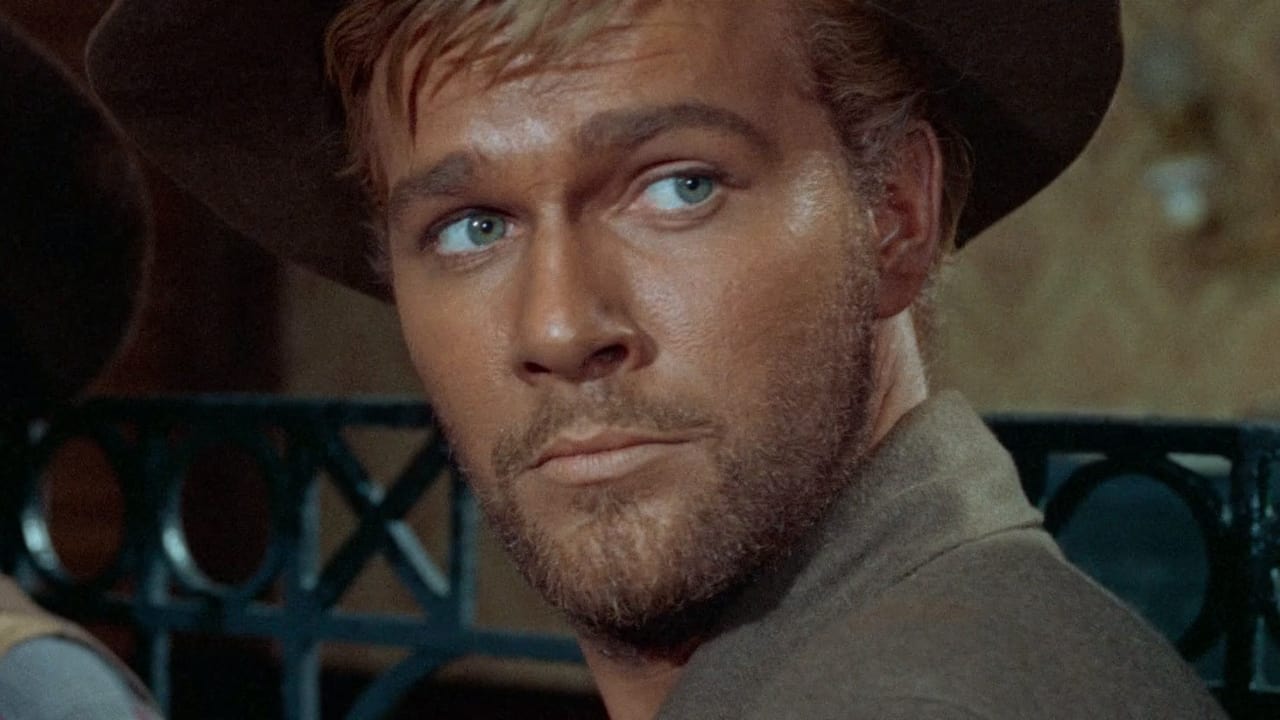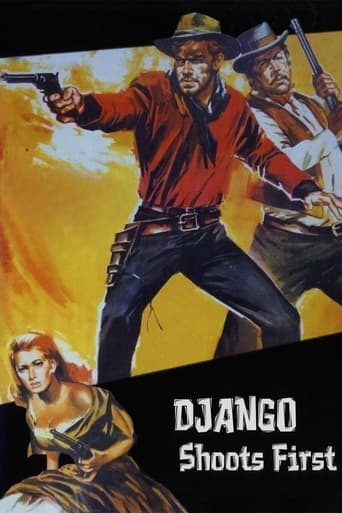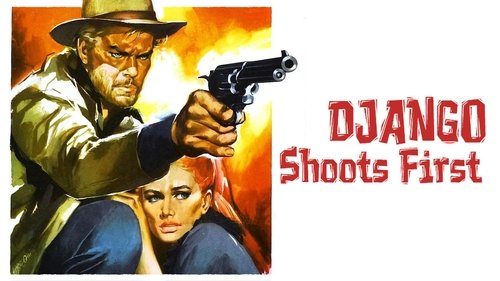


Ever since Sergio Corbucci's seminal Spaghetti Western Django became a big hit in 1966 in both Europe and the United States. They have been a number of producers and distributors who sought to cash-in on the ensuing Django craze by making quasi sequels. Some of them, have nothing to do with grimy Franco Nero's avenging gunfighter who drags coffins around, and a good example of one is this movie. Django Shoots First also known as No Mercy for Django, He Who Shoots First, Django- Only the Colt was his friend, I am Trinidad, and Do not Django Shoot; has nothing to do with the Sergio Corbucci's character, other than his name happens to be Django. The movie also tries to rip-off characters such as Clint Eastwood's Man with No Name 1964's Fistful of Dollars, Lawrence Dobkin's 1966's Johnny Yuma and Gianni Garko's Sartana. In this version directed by Alberto De Martino, Glenn Garvin AKA Django (Glenn Saxson AKA Roel Bos) is hunting down the bounty-killer, Ringo (José M. Martín) for killing his father. When he finds out that Ringo has already killed his father. Django kills Ringo, and heads into the town of Silver Creek to collect the bounty. It's odd that the person that plays Ringo seem more like Django, than Glenn Saxon's character. This main character in this film seem less like Django and more like Giuliano Gemma as Ringo in 1965's Ringo. Anyways, when he gets to Silver Creek, it's there that he learns that his father actually owned most of the town along with a banker named Ken Kluster (Nando Gazzolo). Kluster tries to turn Django away, but the man is determined to stay and claim his portion of the town after discovering that his father's death was set-up. Django gets help from a mysterious stranger named Doc (Alberto Lupo), as well as some townsfolk like Gordon (Fernando Sancho) to fight Kluster, setting a war between the two camps. Only one team can survive. Who will it be? Watch it to find out! Although the synopsis seem simple, Django Shoots First is a very well scripted film with good characters with clever twists. The movie plot mirrors that of Alexandre Dumas' The Three Musketeers, but the Spaghetti Westerns add something new to it. Central characters like Django are defined not by their black and white moral code but, instead, by their moral flexibility, unpredictability, and cynicism. Simply, they were the defining anti-heroes of a genre that previously had been defined by clear cut perceptions of morality, justice, and manifest destiny. After all, Django is going after money, he really didn't earned. Could, the movie be helped if Ken Kluster was made to be more evil and Django more the hero? Yes, but it wasn't needed. Ken Kluster pretty much mirrors Django in every way. Both are willing to trick the public to get their way. Some people might hate it, but I didn't find it, unlikeable. Maybe, it gave the movie more depth. At less, it gave a pretty funny clever ironic punchline ending. Even the gun-fight action seem more realistic than a lot of Spaghetti Westerns. You have shootouts that amplified the tension by relentlessly cutting between wide shot, medium shot, close-up, and extreme close-up of characters, and a camera that sits unbearably close to character's reaction shots. Still, there were some hammy fist-fights that seem too cartoony even for my taste; mostly toward the end, where the movie morph in a near comedy with the bar room fight. The movie pacing might have done a little too long. They should had stop, after reaching the cave. For a Spaghetti Western, it's not that violent, but it didn't felt gimmicky. Not a lot of one-shot kills in here. You see all the ingredients for a good Spaghetti westerns like the pronounced use of widescreen vistas and extreme close ups. The sets and costumes all look strong and good use is made of the Spanish locations that give this film a very traditional Western feel. Indeed it was made in a Sergio Leone's style of filmmaking. The acting is pretty good for the most part. I did kinda mistake Fernando Sancho for Bud Spencer. Both are very similar in the way, they act. I'm still convince that is Bud Spencer in this film, but I might be wrong. One of the best part was George Eastman's cameo. So look forward to that. One thing; that was a bit disappointing is the female leads. Both Erika Blanc as the American Girl, Lucy & Evelyn Stewart AKA Ida Galli as femme fatale, Jessica Kluster are beautiful and alright in acting, but there are missing a lot of depth in their characters. The music score by Bruno Nicolai is beautiful and pretty catchy. While "Bolero" sung by Dino is great, it still sounds like something out of a 1960s James Bond movie. It might be a little out of place. Still, it was good enough that 2004's video game, Red Dead Revolver to use it. The movie is kinda hard to find, but most copies are decent. The DVD version that I had, had alright picture quality with some light grain throughout and some occasional print damage. The English dubbing was alright and the sound was very good, throughout the film. Although forced subtitles are not ideal and not there. Dorado Films is actually pretty good choice. Overall: This is a must-own Spaghetti Western. Recommended to genre fans.
... View MoreThis atmospheric but low-budget Spaghetti western about a gunslinger who turns in his own father for the reward on his head is worth watching at least once. Mind you, I don't think it qualifies as a classic Spaghetti western. While it cannot compare with classics such as "Fistful of Dollars," For a Few Dollars More," "The Good, the Bad, and the Ugly," "Death Rides A Horse," "Django," "Navajo Joe" or the "Sabata" movies, "Django Shoots First" is adequate enough for fans to appreciate. Rugged, virile-looking Glenn Saxson cuts an appropriately heroic figure as the protagonist, while chubby Spaghetti western stalwart Fernando Sancho appears ideally cast as Garvin's loyal sidekick Gordon. Imagine a thickly-mustached Andy Devine without his wheezing laughter but armed-to-the-teeth, and you've got an adequate description of Fernando Sancho. No, Sancho isn't cast again as a ubiquitous Mexican bandit as he is in some many other continental horse operas. Gordon has his own reasons for riding with Garvin as he points out half-way through their sagebrush shenanigans: "You're one in a thousand. You're the performing kind. Why I'd walk a long way just to see your act." An elegantly attired former physician (Alberto Lupo of "Son of Cleopatra") with a cane that he wields when he makes a point joins . Shoot-outs and fistfights galore ensue. "Operation Kid Brother" director Alberto De Martino lacks the Leone touch, but he doesn't drag things out unnecessarily in this 82-minute outing. Scenarists Sandro Continenza of "For A Few Extra Dollars," Massimiliano Capriccioli of "Wanted," Tito Carpi of "Any Gun Can Play," Vincenzo Flamini of "$100,000 for Ringo," Giovanni Simonelli of "Johnny Yuma," and De Martino weave sufficient humor into the storyline to take the edge off some of the cruelty. This isn't a mean-spirited Spaghetti western. "The Five Man Army" musical director Bruno Nicolai's vibrant orchestral score enlivens the proceedings. "Massacre Time" lenser Riccardo Pallottini makes this western look better than it deserves, and the scenery looks spectacular. Genre regular George Eastman has a cameo near the end that is amusing.As the action unfolds in "Django Shoots First," Garvin (Glenn Saxson of "Go with God, Gringo") guns down Ringo, (José Manuel Martín) the black-clad, bounty hunter who shot his father for a $5-thousand reward. The ill-fated bounty hunter rides into Garvin's campsite, and Garvin guns him down. Afterward, Garvin takes the body of his father back into town and collects the loot. Garvin is surprised when he learns that his father owned half of the town with another man named Ken Cluster. The dastardly Cluster wants Garvin out of the way and dispatches his gunslingers to kill him. Eventually, Cluster frames Garvin for the murder of a bank cashier after one of his henchmen brings him the same knife that our hero uses to kill one of Cluster's henchmen during a nocturnal shoot-out in the desert. Rather than surrender to the local authorities, Garvin shoots it out with them and skedaddles out of town with a posse on his tail.The posse pursues Garvin to Cluster's ranch where Mrs. Jessica Cluster (Evelyn Stewart of "Adios Gringo") allows him to hide in her bubble bath when the sheriff storms into her house. An amusing moment occurs when Garvin parades around in a dressing gown with his gun belt strapped thwart his hips. Cluster assembles a small army of gun hands to track down Garvin. Doc warns Garvin not to trust Jessica, and he reveals that Jessica is really his wife. Jessica rides to where Ward (Guido Lollobrigida) is hiding and instructs him to deposit the loot in her name in a bank. Garvin,Doc, and Gordon prepare a little reception for Cluster's men. After our heroes ambush Cluster's men, Garvin rides after Ward. These scenes resemble something out of an American B-movie western with the hero catching up with the fleeting outlaw, bull-dogging him off his horse, and the two smashing each other with their fists. Eventually, Garvin and Gordon conceal the loot that Kluster stole from his own bank, but Jessica discovers the money, too. The ending is clever because our heroes believe that they have made off with the loot for Mexico."Django Shoots First" is an average Spaghetti western.
... View MoreAlthough no authority in the field, I've seen enough Italian westerns to know that they're ALWAYS worth peeping if only for A) the music, B) the women and C) the violence which is more gritty and relentless than in westerns produced in any other country. The legendary work of Sergio Leone and Sergio Corbucci naturally state this theory the most, but even all the obscure and low-budget genre efforts coming from this country are worth tracking down. Particularly the numberless "Django" rip-offs/unofficial sequels are immensely entertaining, like for example this exciting & surprisingly humorous adventure directed by Alberto De Martino. Glenn Saxson (a Dutch guy) takes over the title role of cult icon Franco Nero and, although not half as charismatic as Nero, he does a fairly adequate job as the indefeasible gunslinger hero who like the title implies always shoots first and never ever misses his target. The screenplay of this film is compelling and actually rather clever, and there isn't a single dull moment throughout the entire playtime. We meet Django as he recovers his father's dead body from a bounty hunter. Since there was the huge reward of $5.000 on his head, Django decides to collect the money himself instead of respectfully burying his father in a last resting place. Shortly after his arrival in town, however, he learns that his father wasn't a criminal at all, but a businessman framed by his former partner & bank owner Kluster. With the help of a few friends he met in the saloon, Django stays to avenge his father and claim his rightful inheritance which is about 50% of the entire town. You may anticipate all the regular ingredients of Spaghetti Westerns, like outrageous bar fights, grisly vendettas and violent ambushes, but there's also room for original sub plots in this film! One of Django's accomplices, for example, hides a mysterious secret that only gets revealed late in the film and then neatly fits in with the main storyline. Also, the film's whole climax (and particularly the comical epilogue) is very spectacular and creative. Bruno Nicolai's musical score is phenomenal as usual and both Ida Galli & Erica Blanc provide the required female beauty. "Django Shoots First" is a minor must-see for die-hard fans of this sadly extinct Italian genre.
... View MoreThis Spaghetti Western isn't as bad as it's been described in "Stracult", a compilation of essays on Italian B-movies that I purchased at the 2004 Venice Film Festival, but it's certainly not anything special either! Glenn Saxson is a cheerful lead in the Errol Flynn vein, which is incongruous for the genre - at least in this early phase, before comedy set in with the Terence Hill/Bud Spencer films!Still, the revenge/control-of-a-Western-town plot is fairly engaging - though it has nothing whatsoever to do with the original DJANGO (1966; whose 2-Disc LE Set via Blue Underground, incidentally, I should be receiving soon) - and even includes some nice, original touches: Django taking his outlaw father's corpse (after dispatching the bounty hunter who murdered him) to town to pick up the reward money for himself; a "Three Musketeers"-like subplot involving a beautiful but wicked woman (Evelyn Stewart) and her former husband, friend of the hero, who warns him against her; an amusing double-twist at the end in which, first, heroine Erika Blanc outwits a fleeing (i.e. uncommitted) Django, thus making sure that he goes back to her - followed by a reprisal of the film's opening sequence with the arrival of a new gunslinger in town, this time to challenge Django's own authority! The climax, set inside a graveyard, is also effective - as is Bruno Nicolai's bouncy score.Having said that, the film is too slowly-paced and, even at a little over 90 minutes, it feels protracted - particularly the silly bar-room brawl towards the end!
... View More